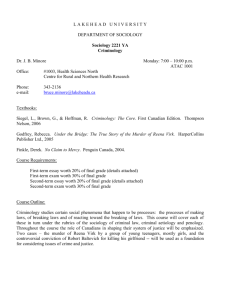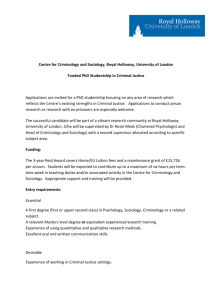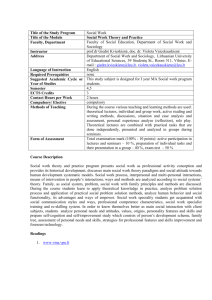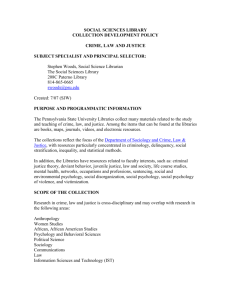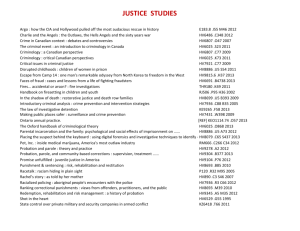Sociology 2221 YA Criminology
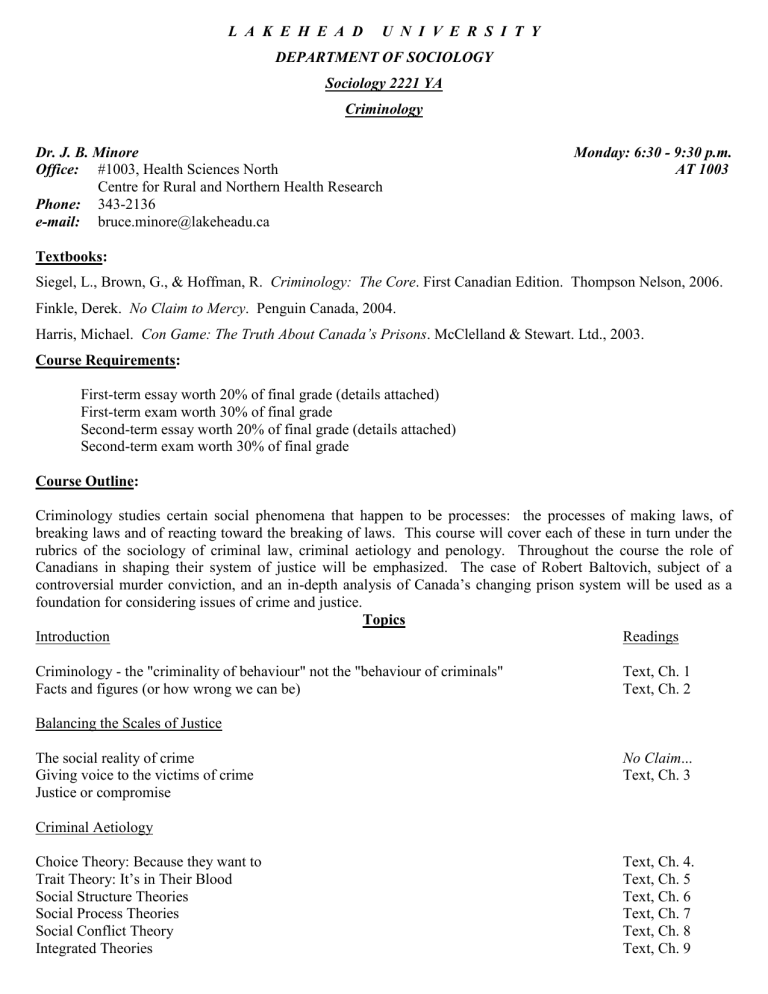
L A K E H E A D U N I V E R S I T Y
DEPARTMENT OF SOCIOLOGY
Sociology 2221 YA
Criminology
Dr. J. B. Minore
Office: #1003, Health Sciences North
Centre for Rural and Northern Health Research
Phone: 343-2136 e-mail: bruce.minore@lakeheadu.ca
Textbooks:
Monday: 6:30 - 9:30 p.m.
AT 1003
Siegel, L., Brown, G., & Hoffman, R. Criminology: The Core . First Canadian Edition. Thompson Nelson, 2006.
Finkle, Derek. No Claim to Mercy . Penguin Canada, 2004.
Harris, Michael.
Con Game: The Truth About Canada’s Prisons
. McClelland & Stewart. Ltd., 2003.
Course Requirements:
First-term essay worth 20% of final grade (details attached)
First-term exam worth 30% of final grade
Second-term essay worth 20% of final grade (details attached)
Second-term exam worth 30% of final grade
Course Outline:
Criminology studies certain social phenomena that happen to be processes: the processes of making laws, of breaking laws and of reacting toward the breaking of laws. This course will cover each of these in turn under the rubrics of the sociology of criminal law, criminal aetiology and penology. Throughout the course the role of
Canadians in shaping their system of justice will be emphasized. The case of Robert Baltovich, subject of a controversial murder conviction, and an in-depth analysis of Canada’s changing prison system will be used as a foundation for considering issues of crime and justice.
Introduction
Topics
Readings
Text, Ch. 1
Text, Ch. 2
Criminology - the "criminality of behaviour" not the "behaviour of criminals"
Facts and figures (or how wrong we can be)
Balancing the Scales of Justice
The social reality of crime
Giving voice to the victims of crime
Justice or compromise
No Claim ...
Text, Ch. 3
Criminal Aetiology
Choice Theory: Because they want to
Trait Theory: It’s in Their Blood
Social Structure Theories
Social Process Theories
Social Conflict Theory
Integrated Theories
Text, Ch. 4.
Text, Ch. 5
Text, Ch. 6
Text, Ch. 7
Text, Ch. 8
Text, Ch. 9
Sociology 2221 YA
COURSE OUTLINE
Penology (the treatment of the criminal in Canadian society)
Decision makers - the police (lectures)
Violent Crime (reading)
2 Dr. B. Minore
2005-2006
Text, Ch.10
Decision makers - the courts (lectures)
Property Crimes (reading)
Detention - lectures & reading
White-Collar and Organized Crime (reading)
In the community
Probation and parole (lectures)
Public Order Crimes
The system in perspective
Continuity and change (lectures)
Compulsory First-Term Essay Question worth 20 marks :
Text, Ch.11
Con Game
Text, Ch. 12
Text, Ch. 13
(To be answered as part of the First-Term examination)
(i) Critics have argued that the prosecution of Robert Baltovich occurred because of the authorities "tunnel vision" -- their unwillingness to consider or pursue information which did not fit with their theory that Mr.
Baltovich was responsible for the murder of his girlfriend, Elizabeth Bain. In No Claim to Mercy , Derek Finkle details many instances of such fixed thinking. Give ONE example in detail from either the police investigation or the Crown's prosecution of the case. Explain why the example you have chosen could have contributed to Mr.
Baltovich’s conviction. And explain why the authorities directly involved in the decisions relating to this matter would chose to ignore or discount contradictory evidence.
(ii) In July, 2005, Robert Baltovich was ordered to stand trial for a second time. At an appeal hearing the court heard evidence (much of it related to Paul Bernardo) which his lawyers claimed made it “highly arguable” that a miscarriage of justice occurred and, also, about “several omissions and errors” made by Judge John O’Driscoll at the original trial that they felt twisted the interpretation of evidence to favour the prosecution. Cite ONE example of judicial intervention and explain how it could have affected the outcome of the jury’s decision at the original trial. Can we ensure that a jury-based criminal justice system will not make errors and convict innocent people? If you answer "yes", explain why? If you answer "no", explain why not?
Compulsory Second-Term Essay Question worth 20 marks :
(To be answered as part of the First-Term examination)
(i) In his book, Con Game
, Michael Harris documents what he considers to be the failings of Canada’s federal prison system. Many of these are linked to the corporate priorities of the Correctional Services of Canada (CSC).
State what the key priority is, according to the author, and explain why CSC has adopted it. What is the role of the
National Parole Board in making sure that this priority is implemented? Illustrate the potential consequences, using the Thunder Bay case of Michael John Hector (outlined in chapter 11). Are criticisms of the board, based on such tragic events, reasonable? Explain.
(ii) In Chapter 12, New Directions , the author discusses alternate approaches recently adopted in Ontario to counteract perceived mistakes of the federal system. Compare and contrast the two systems with respect to: penal philosophy, approach to parole, handling of drug/alcohol offences, and cost containment.
